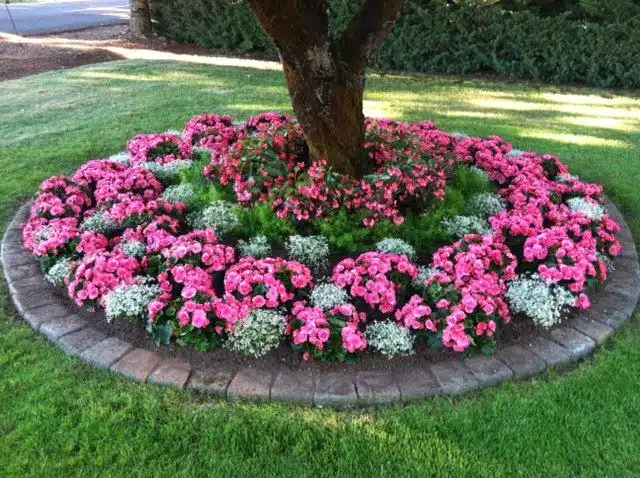If you find it difficult to know what to plant beneath a tree, then you’re not alone. The shade from trees can make things tough for smaller plants, taking away nutrients and water causing them not to flourish as they could – but there are ways around this!
When it comes to gardening beneath trees, the key is to know which plants to choose that are aptly suited for such an environment.
Hostas – Hostas are perennials with attractive foliage and are the perfect plant for beginners because they’re easy to grow and are quite hardy in nature! Hostas do very well in a filtered light situation under the canopies of trees. They do require some light (as do most plants) and some occasional watering in those long dry hot spells. Once established though, they can take the summer heat and withstand mild droughts. Though mainly known for their interesting foliage, these plants also produce lovely flowers in pink, lavender, light blue, or white from early summer to early fall. Hummingbirds and other pollinators love the flowers, which may even be fragrant, depending on the variety.
Sedum – Sedum, or stonecrop is a succulent plant that grows well beneath the filtered shade of a tree. Some perennial varieties can be found growing low and used as ground cover but with so many different species available for you to choose from, you will be sure to find the one you need! The ground cover sedum does well in filtered shade – whereas the taller stonecrop varieties prefer full light in order to flower their best. Sedum is low maintenance, very heat and drought tolerant, relatively inexpensive, and is resistant to pests and disease. The bright foliage and flowers are very eye catching. The low stonecrop is renowned for their ability to spread quickly, which help keep weeds from taking hold.
Hydrangeas – With bountiful flowers and exceptional versatility, it’s no wonder that hydrangeas have become so popular among gardeners! With a wide range of varieties available, there is a hydrangea for nearly every garden. While they are known for their beautiful flowers, did you know they’re also quite easy to grow? Hydrangeas like being kept consistently moist and will do well when planted beneath a tree or in partial shade. They also like the acidic soil and mulch of a conifer tree. They do enjoy some morning sun and some of the newer varieties can handle more sun and heat. Be sure to read the plant’s label before purchasing so you know if that particular hydrangea prefers sun or filtered light from trees. Big Leaf Hydrangeas (Endless Summer) are a variety that can handle more shade. To be safe, it is best to plant your hydrangeas out of reach of the tree’s main roots.
Pieris Mountain Fire
The Pieris Mountain Fire is a fabulous and unique perennial shrub that adds bold color to your landscape with minimal maintenance. Shade and drought-tolerant this hardy shrub is perfect as a focal spot with its exciting red and green foliage and branches of white blooms.
It is a slow grower that reaches about 4 feet tall and 3-4 feet wide over the first 10 years, but as it matures further it will continue to grow but rarely will it reach over 8 feet tall and 6 feet wide.
Impatiens
Impatiens are excellent plants for planting under trees. As annuals tho, they must be replanted annually. They love to be fed and watered and can tolerate deep shade. They will perform best in moist, well-drained soils in partial shade. Areas that receive 2 to 4 hours of filtered sun during the day or morning sun and afternoon shade are usually the ideal locations. Impatiens can also be grown in heavy shade. However, keep in mind that the plants will be taller and bloom less profusely in heavily shaded locations.
Begonias
The begonia is a favorite among gardeners who want to add some eye-catching color to their landscape. This annual flower typically comes in all kinds of colors, including yellow, pink, red or white with orange being one of the most popular color options.
Begonias are a garden classic for good reason: They are ab easy-to-grow plant that takes root in a variety of conditions and requires little to thrive. They come in many shapes, sizes, and colors and will reward you with stunning flowers and foliage. Some plants showcase single flowers with just one row of petals, while others have double blooms with numerous rows of petals.
Begonias are tolerant of a range of light conditions, from full sun to shade. In regions where the temperatures rise, they need protection from the hot afternoon sun to prevent leaf scald. Varieties with darker foliage can withstand more light than those with green leaves.
Coleus
Coleus does best in partial to full shade, though many newer varieties can tolerate full sun.
Coleus are low-maintenance plants with attractive foliage. What makes them so popular is its versatility: they are easy to grow, stay vibrant in both sun and shade, and tolerate almost any soil type.
The blue or white flowers on the mature plant are a colorful addition to the already bright foliage. Many gardeners will remove them to encourage more brilliantly colored leaves giving the plant a fuller look. Planted in spring, coleus provides season-long color, dying back with the first frost.
The amount of sun or shade coleus needs depends on the variety. Newer varieties, like the Wizard series, are more tolerant of sun than some of the older types. Most varieties are suited to shady spots and do well with morning sun and afternoon shade.





